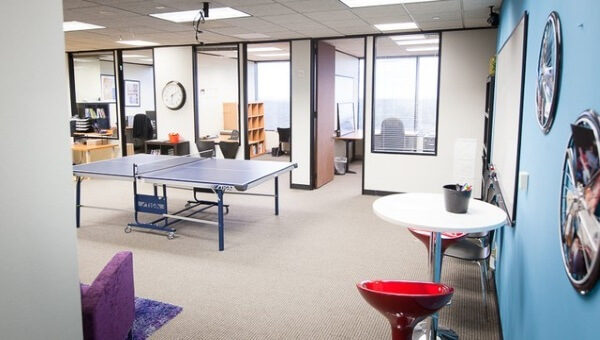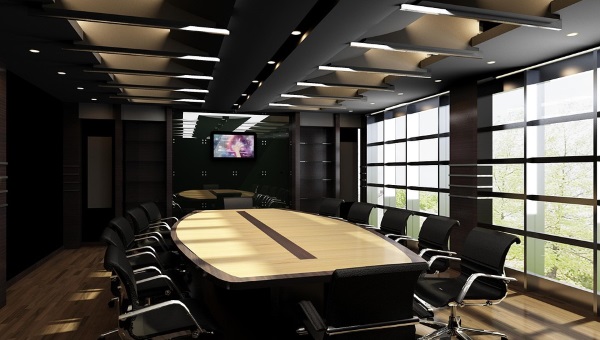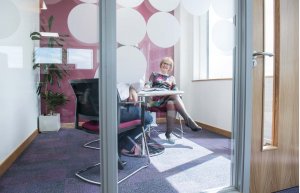Lighting is an integral part of office design and, just like the layout of an office, it can have a huge impact on the people who use the space.
Lighting can affect everything from
how people make decisions – brighter lighting causes people to respond more emotionally – to
how well people sleep at night; dim lighting causes restless sleep. Lighting design can be overlooked when thinking about office design, but it can have a significant impact on the health of your staff and your company image.
Below are five key ways that office lighting can impact on the wellbeing and productivity of staff and how it can help you make the best impression on clients.
1. Fitting LEDs will save money and provide a better quality of light
Fluorescent tubes have long been the bulb of choice for offices as they are cheap to buy and fit, suitable to be installed in suspended ceilings and can light large areas. Common problems with fluorescent tubes however include flickering and bulbs becoming dimmer with age, mean that the quality of light can be inconsistent. This, combined with problems such as buzzing, means they are far from the ideal choice for offices.
A popular alternative to fluorescent tubes, and one that we specify regularly in our designs, is the LED light. LEDs have often been seen as an expensive option for offices, but in the long term they are more cost-effective than fluorescent lighting.
LEDs are far more energy efficient than fluorescent tubes and other bulbs such as HID lamps, as LEDs last far longer and use much less wattage to operate. Another environmental benefit of LED tubes is that they don’t contain mercury and other chemicals found in fluorescents, which can be harmful to the environment.
T8 tubes are one of the most common sizes of tube used in commercial spaces – the ‘8’ in T8 refers to the diameter of the tube in eighths of an inch, a T8 is eight-eighths of an inch, or one inch, in diameter.
T8 LEDs can last for up to 50,000 hours, 20,000 hours longer than the average fluorescent T8, meaning they need replacing far less frequently. For a more modern look, LED panels can be fitted into suspended ceilings in place of traditional light fittings.
LED panels help to eliminate glare, which can improve comfort and productivity in the office.

Thinking about a new design for your office but don’t know where to start? Download your free guide here.

2. Utilise natural light
Natural daylight is one of the best assets in office design as it can make an office look instantly brighter and more welcoming. Ideally, natural light should take the lead, with artificial lighting increasing the light to sufficient levels – the goal should be to make people feel connected to the outside world whilst being able to work comfortably. Good levels of daylight in an office
can increase productivity and sales by up to 40% and creativity by 15%. Employees who have more exposure to natural light
sleep longer, exercise more and have a better quality of life than those exposed to less light. Anecdotal evidence suggests that commercial buildings with no windows are worth
about 20% less in rent than those with windows; therefore if you are a landlord it’s well worth considering utilising natural light as much as possible in an office. Lighting an office naturally can cut energy costs too, as more natural light in an office means less artificial light is required, another financial bonus of maximising natural light levels.
Daylight integrated lighting control systems (also known as daylight harvesting systems) can regulate the level of artificial light in response to the level of natural light in a space. This means that the artificial light will be automatically dimmed in accordance with the level of natural light present.

3. Install a lighting control system
Lighting control systems are designed to save energy in an office building by responding to how each area of the office is used. Adding a lighting control system into an office redesign or fit out means you can get the most out of any new lighting that has been installed in terms of performance and energy saving capabilities.
As well as making the most out of natural daylight, lighting control systems will help you to save money by regulating the lighting in different areas of your office. Areas that aren’t in constant use, such as corridors, toilets and meeting rooms, will benefit from a lighting control system as this will ensure these areas are only lit when they are in use. Occupancy control sensors ensure that the areas are lit when in use and that lights are switched off when they are not needed.
Lighting control systems add a level of flexibility to lighting that is vital in modern offices. Dimmer switches can be installed to control light levels in meeting rooms where projectors are used.
Blinds and window dressings can also be considered as lighting control systems. Perforated blinds maintain the view outside of a window whilst redirecting sunlight onto the ceiling. This makes them a good choice when redesigning an office.

4. Lighting suitable for every task
Each area of a modern office demands its own type of lighting to suit the requirements of the people working there. It’s vital that lighting is incorporated into a newly designed office so that your employees can work comfortably and effectively. Open plan offices can easily become flooded with artificial light as ceiling lighting has to be strong enough to illuminate people’s desks. This can lead to glare from overhead fluorescent lighting and
over-illumination, which can have a negative impact on people’s health and lead to unnecessary energy wastage.
Lighting should be layered to avoid over-illumination, so instead of all the light coming from the ceiling, this general lighting is layered with ambient and task lighting, to allow greater control of how an individual’s workspace is lit. For example, an adjustable desk lamp provides extra light when working on specific tasks and an adjustable floor lamp will allow individuals to personalise their lighting.

5. Use lighting to zone different areas
Lighting can reinforce your brand values and complement your office design to create a striking first impression. Lighting can help to define different areas in an open plan office, optimising the space available. Below are some ways that lighting can help create designated areas in an office:
- Over-sized pendant lights hung above a large table can help define this area as a place for meetings and get-togethers, even if it is part of an open plan office.
- Spotlights can lead the way down corridors, directing people to different areas of the office or building.
- Low lighting in booths or small nooks can help to convey the impression or privacy.
- Breakout areas and lounges are the ideal place to introduce quirkier lighting design choices such as: different colours; accent lighting to highlight shelves or plants; and bulbs and lampshades of different sizes and shapes.
In all areas, you can add flexible features such as dimmer switches, standing lamps and table top lamps to give people control over the light levels and mood of the area, whether they want to work, eat, meet or relax in those areas.













